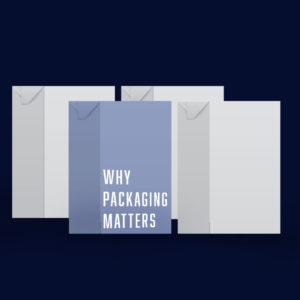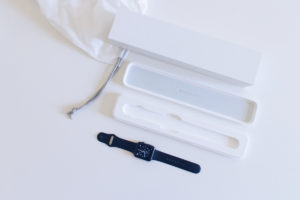Of all the design work I’ve done over the years, packaging design is probably the second most skipped design area. Proper branding in my opinion is the most skipped area. Packaging design is often an afterthought, the focus is usually on the product itself. It shouldn’t be. It’s a core part of your product and should be given the time and resources it needs. Let me show you why.

No matter what size you are, packaging is important. Especially when talking about physical product packaging. Packaging helps create the experience of buying and getting your product and it can help explain how to use the product. It protects the product during shipping and is usually the first thing to catch a potential buyers eye, even online. So, let’s dive into the 5 reasons packaging design matters!
Creates An Experience
Packaging is experiential and you can make that experience whatever you want through how you design it.
Ian Peterman, CEO Tweet
The iPhone is a great example because it really showed that packaging mattered to many consumers. There are entire YouTube channels focused on unboxing products. Creating a great experience from the time they start opening your packaging is important.

Part of the Peterman Method™, our conscious design process, is Experience Coherence. This focus is to ensure the experience of your users and customers is the same the entire way through, at every touch point, and enjoyable. Packaging can make a product look more luxury, utilitarian, or any other direction you desire.
Protects During Shipping
Who wants a broken product? No one. It costs everyone money and time, and leaves dissatisfied customers. Especially with today’s world, shipping a product multiple times is typical. This is a typical path a product takes today: manufacturer > warehouse > distribution center > store/customer. It can also go to several different distribution centers depending on how the business is set up. Packaging can also be multi-part. You can have packaging for distribution where multiple units might ship together in a box. That’s in addition to the customer level packaging that gets to the customer or store shelf.
Instructions
Packaging is a great place to include instructions or helpful tips!
Ian Peterman, CEO Tweet
Good packaging can also provide the instructions for using, setting up, or repairing the product. In a world where instructions need to cross language and ability barriers, they are very important to your packaging design.

Even if 95% of your customers don’t read them, or follow them, making sure they are there will ensure that 5% of your customers are happy with the product because they followed the instructions and use your product correctly now. That could be a 5% improvement of how people view your products, just by adding instructions that are usable and easy to your product. Packaging design must include this key component.
Sales
Your packaging is sometimes the best salesperson for your product. In a store, there isn’t anything else there for a customer. Yes, they have a phone they can look things up with, but if you give them all the information easily on the packaging, you make their life easier. You also make it so that they aren’t looking at a hundred other products while trying to find information about your product, right in front of them. Creating the right information to go on the packaging also gives you good sales copy for your website, amazon listing, or anywhere else you sell the product.
Brand Recognition

Packaging is an easy place to build brand recognition with.
Ian Peterman, CEO Tweet
Your packaging is a great way to share your brand and increase brand recognition. You’ll use photos of it online, and in a store it gets your brand in front of people. They might not buy right away, which is ok. Making sure your brand is clearly shown on your packaging makes it a great tool for your company as a whole. Making sure your packaging is on brand is important, it should always match with your existing brand.
While most of this really applies to physical products, it can also easily translate to digital ones, just the packaging could be the user interface, trial/demo version, or in the manual. Make sure your packaging is done right the first time, you never have a chance for a first impression. We’re one of the best product packaging design companies around and I’d love to help you. If you don’t go with us, make sure you find someone with the experience to make your packaging take advantage of these 5 areas in making your packaging amazing.
Your Next Steps
Packaging Design timeline
Ever wonder how long it takes to design packaging?
Why Your Brand Matters
Your brand matters tremendously, let's go over why.
Related Conscious Design BLOG Posts
What’s a Feasibility Study?
A feasibility study is a very important step in making sure a product will be successful. I break down what they are and why they matter.
What it Takes to Develop a Smart Product
As the Internet of Things has grown over the years, smart products have become a pretty hot item. Many people have product ideas for turning a “dumb” product into a “smart” one. It’s great, I love that we are improving our tools and gadgets in so many new and interesting ways. Technology is something that amazes me, and will probably continue to do so for the rest of my life. For a lot of people, it might seem like a fairly simple task to just add some electronics to a product and make it smart. You should understand what you or your business will need to developing such a product. You might have gotten an idea about what it really takes in our post a couple weeks ago Time, Budgets, & Luxury, but I’d like to dive more into exactly what it takes to create a smart product. There is a lot of time and effort that is beyond what low-tech products need to become a reality. For us, “smart” is anything that contains electronics that can connect to other electronics, so wi-fi, Bluetooth, NFC, USB, etc, usually there are sensors or other input points that collect data to be shared with other devices. Putting a motor into a mower doesn’t make it “smart”. Putting a computer on board with internet access, connected to an app would make it “smart”. A “smart” product doesn’t always have to touch the internet either, there are many closed circuit smart devices. IOT (internet of things) products MUST touch the internet however. In no particular order, here is a breakdown of everything that goes into developing a “smart” product. This will give you an idea of what you can expect if you choose to dive into this process. Disciplines required Most “dumb” products can get away with just an Industrial Designer or Mechanical Engineer. Both work, but you can read more about the differences in our post3 Things You Should Know About Designers & Engineers. No electronics means no coders, no electrical engineers, and many others. If you are working with basic electronics, such as motors, switches, etc, you can sometimes avoid getting an electronics person involved. BLANK Ian Peterman, CEO Tweet There are many mechanical side people who can make that happen. Now, if we’re creating a “smart” product, we will need these: App Design & Development Electronics Design Electrical Manufacturing Web Design & Development There are possibly a few others depending on how big you go, such as database development, but these areas would cover most of the work needed to get the project done. Time It can easily double the amount of time to design and develop a new product by adding in electronics that would make a product “smart”. Does this mean it would take longer on a calendar? Not necessarily. When we can, we prefer to do side-by-side development of the mechanical and electrical. This ensures both sides work together and keeps the timeline shorter. The collaboration between mechanical and electrical can really build some synergy with the project. The result is that issues can be caught earlier, avoiding them from popping up super late in the process where it’s harder and more expensive to fix. Cost BLANK Ian Peterman, CEO Tweet Double the time, at least double the cost. Electronics are usually more expensive to prototype. The benefit is the manufacturing on the back end makes super components, even fully custom ones. These products also sell for a higher premium than their “dumb” counter parts. Planning Working on more complex projects such as this involves a lot more planning and project management. Here at the Peterman Design Firm, that is one of our core competencies. You need to make sure the firm you work with has experienced Project Managers on its team. They also need to be able to handle the load required to bring such a product to life. BLANK Ian Peterman, CEO Tweet Network We’ve talked about how important your network is in our last post Building Your Network for Success. This is a place where it really matters as you need so many resources to get the project completed. If you are working with some of the very large and expensive firms out there, they probably have such a large in-house team they can handle most things, but you pay for it. Medium sized firms often still have the network and don’t do everything in-house. Small ones and freelancers don’t always have the network you need and are often still building them. The caveat of course is if they have been in business for 20 plus years, they probably have a good network. Feasibility Study BLANK Ian Peterman, CEO Tweet I put this here just because people like to skim, and this is a key part. Feasibility studies should never be skipped with products in this category. A feasibility study is very important to do at the beginning of your project. The firm you choose to use should be able to offer this service by itself. Don’t commit to full development until you know it can be done. A complete feasibility study from the Peterman Design Firm will give you cost expectations for the entire project, time frame, potential issues, project duration estimation and breakdown, and some market information on competitors. If you’d like to learn more about feasibility studies, check out our post What’s a Feasibility Study? When you have a great idea for a “smart” product, it’s at least worth getting a consultation on the idea. If your budget can handle it, a feasibility study would be valuable. Then if it looks good, invest the money. The great thing with “smart” products is that they are in high demand. Plus we seem to be on an exponential growth with them. For now, it’s a trend I feel will stay with us for a while, if not permanently. Your Next Steps Developing Smart Products What does it take to develop a smart product?
5 Tips for Market Research & Analysis
Wondering about Market Research & Analysis? This will give you a few tips on what it is and how to start your own research.


